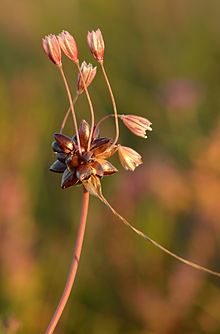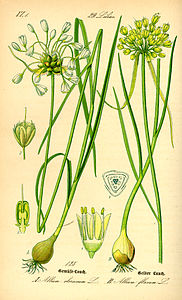Allium oleraceum
| Field garlic | |
|---|---|

| |
| Allium oleraceum | |
| Scientific classification | |
| Kingdom: | Plantae |
| Clade: | Tracheophytes |
| Clade: | Angiosperms |
| Clade: | Monocots |
| Order: | Asparagales |
| Family: | Amaryllidaceae |
| Subfamily: | Allioideae |
| Genus: | Allium |
| Species: | A. oleraceum
|
| Binomial name | |
| Allium oleraceum L. 1753 not Des Moul. 1840
| |
| Synonyms[1] | |
|
Synonymy
| |
Allium oleraceum, the field garlic, is a Eurasian species of wild onion. It is a bulbous perennial that grows wild in dry places, reaching 30 centimetres (12 in) in height. It reproduces by seed, bulbs and by the production of small bulblets in the flower head (similarly to Allium vineale). Unlike A. vineale, it is very rare with A. oleraceum to find flower-heads containing bulbils only.[2] In addition, the spathe in A. oleraceum is in two parts.[2][3]
Its specific epithet oleraceum means "vegetable/herbal" in Latin and is a form of holeraceus (oleraceus).[4][5]
Description[]
Allium oleraceum grows to a height of about 12 in (30 cm). The underground bulb is up to 0.8 in (2 cm) in diameter. The main stem is usually rounded, but is occasionally flattened, and bears two to four leaves and a terminal inflorescence composed of a number of small, stalked, pinkish-brown flowers and sometimes a few bulblets. The papery bracts have long points which often much overtop the flowers, the stamens of which do not protrude.[6]

1885 Illustration

Distribution[]
Allium oleraceum is widespread across most of Europe, with additional populations in Turkey and the Caucasus.[7][1] It is sparingly naturalised in scattered locations in North America.[8][9][10]
In the United Kingdom, A. oleraceum is found in dry, grassy places, usually steeply sloping and calcareous soils, and on open sunny banks in river floodplains. A. oleraceum is scattered throughout England and very scattered in Wales, Scotland and Ireland.[11]: 902 Erosion of coastal areas leads to a reduction in the available habitat for this species, leading to population declines.[12] The highest altitude from which it has been recorded in Britain is 365 m (1,200 ft) in Dovedale, Derbyshire.[13]
Allium oleraceum subsp. girerdii was formerly included, but is now classified as Allium oporinanthum.[1]
See also[]
References[]
- ^ a b c Kew World Checklist of Selected Plant Families
- ^ a b The Reader's Digest Field Guide to the Wild Flowers of Britain p.382.
- ^ Linnaeus, Carl von. 1753. Species Plantarum 1: 299.
- ^ Parker, Peter (2018). A Little Book of Latin for Gardeners. Little Brown Book Group. p. 328. ISBN 978-1-4087-0615-2.
oleraceus, holeraceus = relating to vegetables or kitchen garden
- ^ Whitney, William Dwight (1899). The Century Dictionary and Cyclopedia. Century Co. p. 2856.
L. holeraceus, prop. oleraceus, herb-like, holus, prop. olus (oler-), herbs, vegetables
- ^ McClintock, David; Fitter, R.S.R. (1961). The Pocket Guide to Wild Flowers. London: Collins. p. 205.
- ^ Allium oleraceum L. Altervista Flora Italiana
- ^ Flora of North America v 26 p 238, Allium oleraceum
- ^ BONAP (Biota of North America Program), floristic synthesis, Allium oleraceum
- ^ Gleason, H. A. & A.J. Cronquist. 1991. Manual of the Vascular Plants of Northeastern United States and Adjacent Canada (ed. 2) i–910. New York Botanical Garden, Bronx.
- ^ Stace, C. A. (2010). New Flora of the British Isles (Third ed.). Cambridge, U.K.: Cambridge University Press. ISBN 9780521707725.
- ^ UK Genetic Resources for Food and Agriculture (GRFA) Archived 2008-11-21 at the Wayback Machine.
- ^ "Allium oleraceum". Online Atlas of the British and Irish Flora. Retrieved 13 March 2020.
- Garlic
- Allium
- Flora of Europe
- Flora of temperate Asia
- Plants described in 1753
- Taxa named by Carl Linnaeus


